Strategic Analysis: A Comparative Study of Morrisons PLC and Woolworths Group PLC
Introduction
The report below will describe all about the aspects of an organisational strategic environment which includes internal & external factors, where SWOT & PESTLE analysis has been used as tools. for business dissertation help. The brief showcases all the level of strategic decisions, organisation’s competitors’ analysis using Porter’s Five Forces Framework, the market segments and their strategic capabilities, gaps & choices. Adding to all these the influence of stakeholders and making global strategies have also been presented. In order to conduct evaluation and comparison of all these points, two organisations have been chosen is Morrisons PLC supermarket chain located in UK and renowned as one of the top four retail businesses of UK market & ranking 6th amongst the top 10 in world (morrisons-corporate.com, 2020). To compare with Morrisons, the collapsed chain of Woolworths Group PLC was chosen. Morrisons have 3.0 million workforces with them providing all the necessary items to their customers. On the other hand, Woolworths was also one of the largest Australian supermarket chain that closed on 13th October 2015 (woolworthsgroup.com, 2015). If you are struggling with your business dissertation help, this case study is going to offer the most valuable insights into communication system challenges and potential solutions within the context of an organization.
Strategic Environment

The term strategic environment is a kind of systematic assessment process to support the decisive factors, ensuring that the environmental possibility of being sustainable considering effective plans, policies and programs. In brief the strategic estimation is known as the strategic environment of an organisation, to describe the broader strategic factors influencing the business runner’s understanding of the operational scenario (Anwar et al. 220). Strategic environmental analysis is an assessment to set the global international circumstantial conditions which will influence al the employment elements under the national power. The strategic environment assessment presents the old wide national security challenges that affect the natural products of the enduring human conditions (Butkouskaya et al. 2021). It is necessary to evaluate the organisational strategic environment since it shows the result of policy, plans & program implications & provides a means to look for the future cumulative effects so that they can be addressed at earlier stages of decision making.
Organisational Strategic Environment Analysis (Internal, External, Levels of strategy: corporate, business and operational, Strategic capability, Strategic choices)
Strategic environmental analysis is the process of researching an organisation’s internal and external business scenario where it operates and formulates the planning and decision making for smooth working.
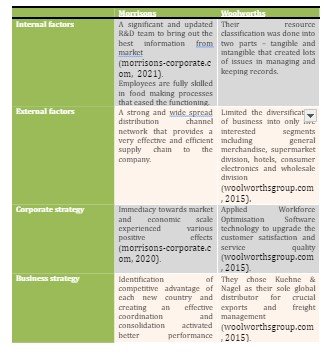

All these determinants of both the Morrisons and Woolworths states their strategic environmental situation due to which Morrisons became one of the top retail supermarkets in UK and on contrary, Woolworths have to shut done years ago and wrap-up their business years ago failing to make the customers attract and run successfully. Both the companies have their own strong points and weak gaps but both handled them differently that is the reason why both stand in different situations in the current market. This reveals that not only having good internal & external stakeholders and strategic choices & capabilities makes a good brand but to reach to the top level every business have to apply exact strategies wherever needed skilfully and utilise the advantages gaining from them so that the set goals can be achieved.
Advantages & Disadvantages of a SWOT analysis
SWOT analysis is the summarisation of all the key factors and issues from any business organisational environment and their strategic capabilities and gaps which are most likely to have an impact on the internal as well as external functioning of that business. SWOT is broken into four segments – strengths, weaknesses, opportunities and threats. From all these four, strength & weaknesses are internal determinants and opportunities & threats are external determinants. Although all of them have benefits and limitations presented here
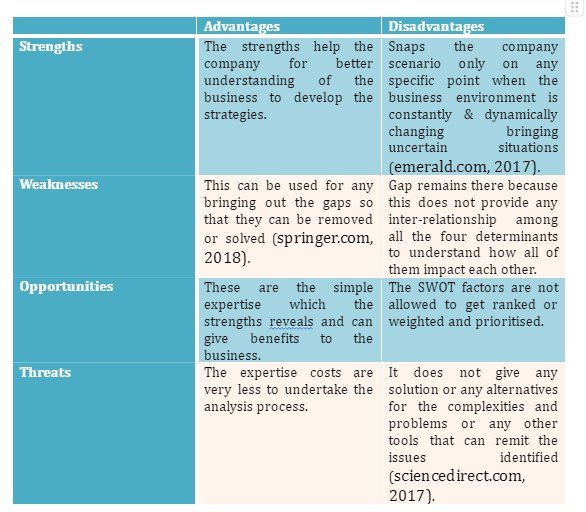
Organisational SWOT analysis
The SWOT analysis of Morrisons will present the strengths, weaknesses, opportunities and threats of the business, their inter-relational scenarios and they all the four determinants can be beneficial to each other for the organisational development and progress.
Continue your exploration of Comparative Study of IBM and Apple with our related content.
Strength
A well efficient and updated distribution channel network and supply chain
Over 500 physical stores only in UK handled by the workforce strength of about 130,000 employees (morrisons-corporate.com, 2021)
Ranked and listed in the FSTE Index & London Stock Exchang
Online shopping and retailing increased the business of the compan
Weaknesse
Handling the vast channel of distributors became difficult and raised issues & conflicts among the price factors (sciencedirect.com, 2017)
Past issues of being alleged for pertaining the farmer rights affected in a huge manner on the brand image of the company which took a lot of time to recover and make a good impression on consumers and create a good place in market
Limited geographical reach as compared with its competitors somehow created a boundary for expand the business
Opportunities
Increasing demand of organic products can be tapped by Morrisons
Threats
Rise in competitor’s’ market share is a big threat to low down Morrisons’s margins
Internationalisation and outbound expansion can be beneficial for Morrisons
Küng (2017) opined that partnerships & acquisition with smaller companies will help to grow
Rising demand of customised products & private label can be catered (morrisons-corporate.com, 2020)
Change in government policies and increased taxes are also counted as threats to badly effect on the business
New e-commerce entrants can hurt Morrisons’s physical retail stores
Market segmentation
Market segmentation of Morrisons is done by keeping in mind the market acquisition options, organic growth facilities which is then followed by the segmentation of the market criteria based on customer preferences towards value for money category, Geographic category, convenience category, servicing category and freshness category.

Strategic gap
One of the main strategic gaps that restricted the business expansion of Morrisons is that their business was limited to UK only and cannot spread in all the countries. This is the main strategic gap in the Morrisons business in which front he competitors are excelling since they did not set any geographical boundary which Morrisons set up (morrisons-corporate.com, 2021). In order to reach to the competitors in global business marketing Morrisons also have to expand in other countries so that more & more consumers get to know Morrisons and can buy products from them. Küng, (2017) stated that this can be done by physical retail stores and also with online shopping sites facilitating all of Morrisons’s products having good shipping advantages.
Strategic influence of stakeholders on organisational culture
A stakeholder is somebody who affects the business entity in many ways and they could be classifies into main two part – internal and external. Both the stakeholders have huge influence on any business. In case of Morrisons, the stakeholders are internal which includes – employees, distributors, suppliers, managers, directors etc. Whereas, the outside stakeholders are consisted of the government bodies, environmental agencies, customers, food & drug departments and others. Internal stakeholders influence the business functioning of internal segments of Morrisons such as the employees, directors and managers are responsible for running the business with good strategical decisions. As defined by Iqbal (2019), the distribution channels and suppliers are responsible for providing good quality products within time and deliver them to the stores so that customer don’t have to return for any of their demand. Same as this the external stakeholders like the customers who are the key stakeholder because without them no business can think of running their organisation. Hoque and Rana (2020) stated that the government bodies, environmental agencies and the food and drug departments are responsible for setting up the standard of products that could be provided to the customers. Hence they set the rules and regulations on all the brand businesses to restrict them from doing anything wrong in order to compete with competitors and also protects the consumer interests.
Analysis of an organisation's Macro-environment using PESTEL analysis
PESTLE Analysis of Morrisons and Woolworths
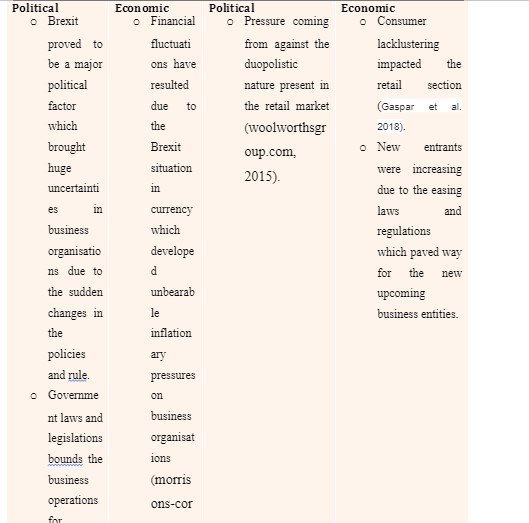
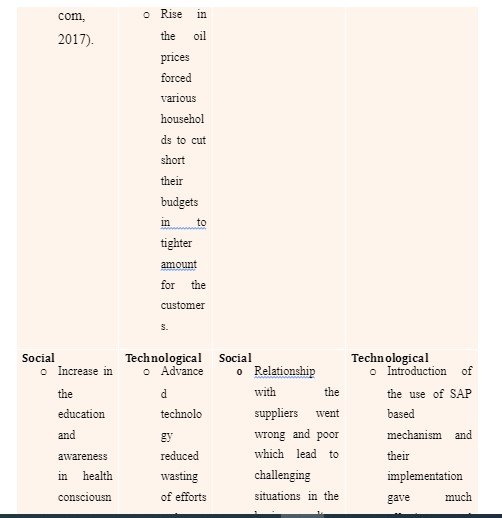
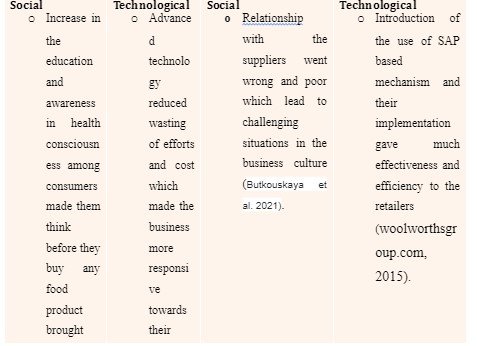
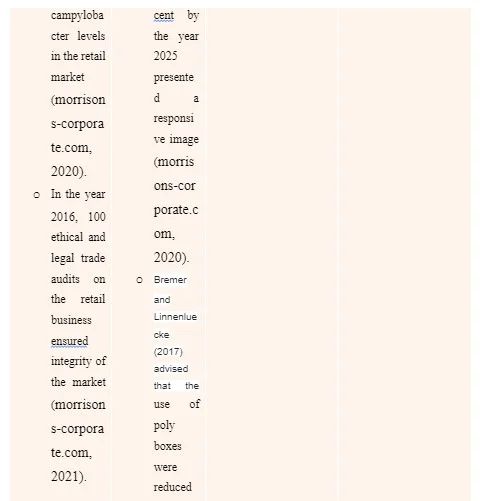
All the external factor of both the businesses either impacted in a positive manner or created negative effects still both of them stand in far different situations where one is leading as top retail business and the other have closed and collapsed years ago. So to maintain a business right strategical choices are must after evaluating al the resources.
Analysis of an organisation's competitors using Porter’s Five Forces Framework
Porter’s five forces is a tool to analyse the competitive advantages of an organisation which was named after Michael. E. Porter in 1979. It has five basic determinants based on which the competitor analysis can be done – threats form new entrants, bargaining power of suppliers, bargaining power of buyers, rivalry amongst the existing entities and threats from substitute products or services. In case of Morrisons also these five determinants are the base upon which the market competition analysis is done here:

Threats from new entrants – Every business entity whether the top most in the list or from below always have the fear of loins the market share of their existing business due to the rise and emergence of new small businesses which if competed with the existing one may bring the established ones down (Arokodare et al. 2019). So Morrisons also requires high capital in the industry to deal with the new entrants.
Bargaining power of suppliers – When the suppliers of existing business gets closely related with good relations or are getting more facilities from the rival companies starts creating issues with the price bargaining. This is a major issue since if the suppliers increase their prices it will make the business also to increase their product prices which might not be accepted by the customers hence the business will lose their customer base (Anwar et al. 2020). Another thing which can happen is that if after suppliers price increase, the business remains their older prices can make them go into loss which ultimately will result in collapse.
Bargaining power of buyers – As the number of business entities will increase the customers will get more shop options to choose from and this is the key fear of every business that they will lose their customer base. So it is very much important for Morrisons to keep up with their consumers with new offers and good quality products and services so that their consumers will not leave them to losses.
Rivalry amongst the existing entities – Number of competitors in which a business organisation deals with is a major factor because as the number of competitors of the same industry will rise the more competitive actions Morrisons have to take in their business functioning. Ali and Varoğlu (2021) suggested that this determinant makes a company to push their capacity and capabilities to the fullest.
Threats from substitute products or services – Substitute products or services are those who can easily take place of the primary product in the industry. Morrisons also faces the same fear of any other substitute product to take place of their ones so they always keeps changing their services and introduces new and advanced products so that the customers won’t get any chance to look towards any substitutions.
Conclusion
This report above presented the scenario of Morrisons PLC supermarket and its various aspects and strategies that lead them to the position of one of the top retailers in the industry. On the other hand as a comparison Woolworth’s supermarket, which was also once a top running business but declared as close and collapsed organisation in the year 2015. The difference between both the companies, their business running strategies, their external impacting factors and internal influencing determinants and their differences were shown. Government laws and legislations bounds the business operations for retailers of food sector were some kind of restrictions for the smooth running of the business entities. Introduction of the use of SAP based mechanism and their implementation gave much effectiveness and efficiency to the retailers. Finally it can be concluded that all the strategic elements and actions of both the businesses either impacted in a positive manner or created negative effects still both of them stand in far different situations where one is leading as top retail business and the other have closed and collapsed years ago.
References
Ali, M. and Varoğlu, M.A., 2021. Revisiting the Mintzberg, Lawrence, and Lorsch theories about organisational structure, strategy, and environmental dynamism from the perspective of small firms. Technology Analysis & Strategic Management, pp.1-15.
Anwar, N., Mahmood, N.H.N., Yusliza, M.Y., Ramayah, T., Faezah, J.N. and Khalid, W., 2020. Green Human Resource Management for organisational citizenship behaviour towards the environment and environmental performance on a university campus. Journal of Cleaner Production, 256, p.120401.
Arokodare, M.A., Asikhia, O.U. and Makinde, G.O., 2019. Strategic agility and firm performance: The moderating role of organisational culture. Business Management Dynamics, 9(3), pp.01-12.
Bremer, J. and Linnenluecke, M.K., 2017. Determinants of the perceived importance of organisational adaptation to climate change in the Australian energy industry. Australian Journal of Management, 42(3), pp.502-521.
Butkouskaya, V., Llonch-Andreu, J. and Alarcón-Del-Amo, M.D.C., 2021. Strategic antecedents and organisational consequences of IMC in different economy types. Journal of Marketing Communications, 27(2), pp.115-136.
emerald.com, 2017. Re-branding the High Street: the place branding process and reflections from three UK towns, available at: https://www.emerald.com/insight/content/doi/10.1108/JPMD-12-2015-0056/full/html [Accessed on: 27th December, 2020]
Gaspar, M.L., Popescu, S.G., Dragomir, M. and Unguras, D., 2018. Defining strategic quality directions based on organisational context identification; case study in a software company. Procedia-Social and Behavioral Sciences, 238, pp.615-623.
Hoque, I. and Rana, M.B., 2020. Buyer–supplier relationships from the perspective of working environment and organisational performance: review and research agenda. Management Review Quarterly, 70(1), pp.1-50.
Iqbal, A., 2019. The strategic human resource management approaches and organisational performance. Journal of Advances in Management Research.
Küng, L., 2017. Digital Transformation. The organisational challenge–creating a roadmap for change. Journalism Report V. Innovation and Transition, pp.171-180.
Küng, L., 2017. Going digital: A roadmap for organisational transformation. Reuters Institute for the Study of Journalism.
morrisons-corporate.com, 2021. About Us- From a Bradford market stall to the UK’s 4th largest supermarket chain, available at: https://www.morrisons-corporate.com/about-us/ [Accessed on: 26th February, 2021]
morrisons-corporate.com, 2020. Corporate Responsibility, available at: https://www.morrisons-corporate.com/cr/corporate-responsibility/?utm_source=corporate&utm_medium=Internal&utm_campaign=footer_link [Accessed on: 3th February, 2021]
Nguyen, T.H.D., Chileshe, N., Rameezdeen, R. and Wood, A., 2019. External stakeholder strategic actions in projects: A multi-case study. International Journal of Project Management, 37(1), pp.176-191.
sciencedirect.com, 2021. Bioenergy development in the UK & Nordic countries: A comparison of effectiveness of support policies for sustainable development of the bioenergy sector, available at: https://www.sciencedirect.com/science/article/pii/S0961953420304219 [Accessed on: 13th January, 2021]
sciencedirect.com, 2017. Stakeholder involvement in strategic adaptation planning: Transdisciplinarity and co-production at stake?, available at: https://www.sciencedirect.com/science/article/pii/S1462901117301296 [Accessed on: 23th February, 2021]
springer.com, 2018. The future of international business research on corporate globalization that never was… , available at: https://link.springer.com/article/10.1057/s41267-018-0192-2 [Accessed on: 15th November, 2020]
woolworthsgroup.com, 2015. Woolworths Supermarkets, available at: https://www.woolworthsgroup.com.au/page/about-us/our-brands/supermarkets/Woolworths [Accessed on: 16th February, 2021]
Continue your exploration of Stakeholder Definitions and Significance in Achieving Organizational Objectives with our related content.
- 24/7 Customer Support
- 100% Customer Satisfaction
- No Privacy Violation
- Quick Services
- Subject Experts



